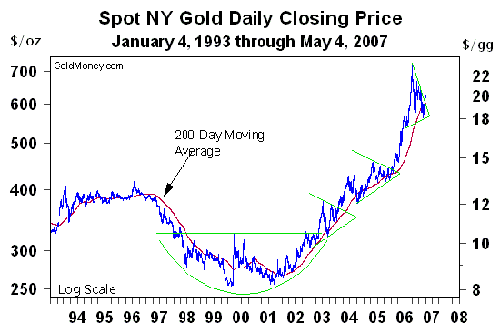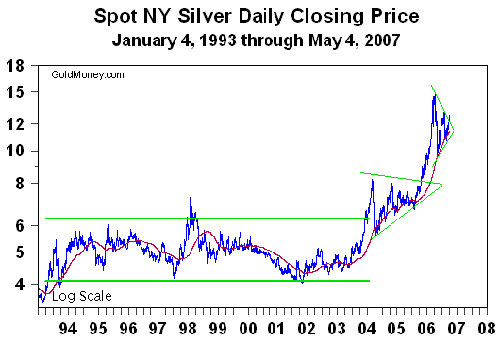Sometimes the markets can be compared to a pressure cooker. We're at one of those moments.
For months the pressure has been building. Gold is clearly undervalued and therefore its price needs to climb higher to bring the market into balance. This balance will occur when new mine production meets the demand for physical metal.
Presently, the demand for physical metal is greater than new mine production, and this imbalance creates the pressure. A higher gold price is needed to reduce demand.
MoneyWeek
Subscribe to MoneyWeek today and get your first six magazine issues absolutely FREE

Sign up to Money Morning
Don't miss the latest investment and personal finances news, market analysis, plus money-saving tips with our free twice-daily newsletter
Don't miss the latest investment and personal finances news, market analysis, plus money-saving tips with our free twice-daily newsletter
Gold price capped by central banks
Gold undoubtedly wants to go higher, but is being prevented from doing so. Central banks fear a rising gold price because it is a widely watched signal that inflation is rising. So rather than let its price rise to reduce demand, gold's price is being capped to make inflation appear tame. The present exceptional demand for physical metal is being met by dishoarding from gold's aboveground stock.
It is of course impossible to precisely measure supply and demand. There are just too many participants in the market, and most don't disclose their activity. The exception of course is central banks. But central bank gold reporting is unreliable, with some banks announcing their dishoarding well after the actual event. Further, they do not report how much gold they lend to bullion banks. This borrowed gold is then sold, thereby putting more physical metal into the market. In any case, here is what we do know.
Over the past seven weeks European central banks have markedly stepped up their dishoarding, clearly indicating that they want to cap the gold price below $700 per ounce ($22.50 per goldgram). They dishoarded 90 tonnes of gold, which is more than one-fourth of the gold newly mined during this same period. It is this price capping that has put gold in a pressure cooker.
Gold price depends on who blinks first
In fact, the lid on that pressure cooker is rumbling. Whether it blows sky-high or not depends on who will blink first. If it is the buyers of physical metal, demand subsides and gold will remain under $700. If it is the central banks, their supply disappears with the consequence that gold will soar to a new multi-decade high above $715. I fully expect the central banks are ready to blink, and when they do, gold will soar higher to relieve the pressure that has been building.
Actually, the following charts indicate that central banks have already blinked. They are losing the battle for $700. Both gold and silver are breaking out to the upside from the triangle consolidation pattern formed in recent months. And look what happened to each metal the last time they broke out to the upside from the other triangle patterns shown on these charts. Both gold and silver began a major uptrend.


Two steps to a higher gold price
These charts show that buyers of physical gold are overpowering the dishoarding by central banks. That is the first step to a higher gold price.
The second step is for gold to be pushed higher by 'hot money' stepping off the sidelines, where it has been parked for months as gold traded within the range that has confined it for the past year. This new buying will put central banks in a dire position, and I suspect they are unwilling to step up the dishoarding necessary to keep capping the price.
Most central bankers have I think learned a lesson from 'Brown's Blunder', the badly timed decision by British Chancellor Gordon Brown to dishoard one-half of Britain's gold stock at the bottom of the market, an event for which he is still being roundly criticized. They don't want to repeat his mistake. But there is also another possibility.
Perhaps the central banks are incapable of dishoarding gold at a higher pace because of their active gold lending and dishoarding in the past. In other words, they may be scraping the bottom of the vault, so to speak, and are running out of gold they are willing to dishoard at today's price. This possibility is worth pondering.
I would like to conclude this alert with the same words I ended the last one: 'Both of the precious metals remain in uptrends. Most importantly, both look ready to break above their multi-decade high set one year ago. So in the coming weeks I expect to see gold and silver exceed their May 2006 high.'
James Turk is the Founder & Chairman of GoldMoney.com. He is the co-author of The Coming Collapse of the Dollar.
Get the latest financial news, insights and expert analysis from our award-winning MoneyWeek team, to help you understand what really matters when it comes to your finances.
MoneyWeek is written by a team of experienced and award-winning journalists, plus expert columnists. As well as daily digital news and features, MoneyWeek also publishes a weekly magazine, covering investing and personal finance. From share tips, pensions, gold to practical investment tips - we provide a round-up to help you make money and keep it.
-
 Metals and AI power emerging markets
Metals and AI power emerging marketsThis year’s big emerging market winners have tended to offer exposure to one of 2025’s two winning trends – AI-focused tech and the global metals rally
-
 8 of the best houses for sale with beautiful fireplaces
8 of the best houses for sale with beautiful fireplacesThe best houses for sale with beautiful fireplaces – from a 15th-century cottage in Kent to a 17th-century palazzo in Oxfordshire

